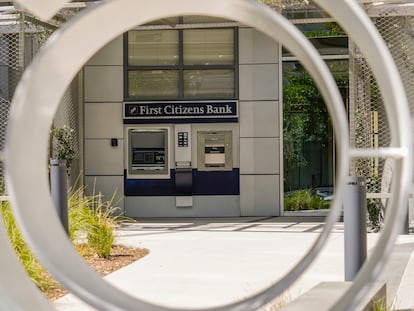U.S. consumer confidence ticks up in March
The Conference Board reported that its consumer confidence index rose to 104.2 in March, even as persistent inflation, bank collapses and anxiety over a possible recession weighed on Americans

Consumer confidence inched up in March after two straight monthly declines, even as persistent inflation, bank collapses and anxiety over a possible recession weighed on American households.
The Conference Board reported Tuesday that its consumer confidence index rose to 104.2 in March from 103.4 in February. Optimism about current conditions fell, though consumers grew slightly more positive about the short-term future. That’s a reversal from recent surveys.
The board said that despite the uptick in confidence, the index remains below 2022′s average level of 104.5.
The business research group’s present situation index — which measures consumers’ assessment of current business and labor market conditions — inched down to 151.1 from 153 last month.
The board’s expectations index — a measure of consumers’ six-month outlook for income, business and labor conditions — rose in March to 73 from 70.4 in February. A reading under 80 often signals a recession in the coming year, according to the Conference Board.
The cutoff date for the board’s poll was March 20, about 10 days after the collapses of Silicon Valley Bank and Signature Bank. There was no specific question about banks in this month’s survey, but in a separate AP-NORC poll last week, just 10% of U.S. adults said they have high confidence in the nation’s banks and other financial institutions. That’s down from the 22% who said they had high confidence in 2020.
Consumer spending, which makes up about 70% of U.S. economic activity, has remained strong despite the Federal Reserve raising interest rates nine straight times since March of last year in its effort to cool the economy and bring down persistent, four-decade high inflation. Those rate increases can raise the cost of using credit cards or taking out a loan for a house, car or other purchases.
On top of that, though U.S. consumer price increases eased slightly from January to February, they still point to an elevated inflation rate far above the Fed’s 2% target.
The board said that the latest results showed that consumer expectations about inflation remain elevated. Those planning to spend on major appliances fell, while plans for car purchases rose slightly.
The board added a special question to this month’s poll, asking consumers about their plans to spend on services during the next six months.
The results showed that consumers planned to spend less on “highly discretionary” categories such as playing the lottery, going to amusement parks, movies, lodging and dining out. Those respondents indicated they plan to spend more on less discretionary things such as health care, home and auto maintenance and tax preparation.
Respondents to the Conference Board’s survey were slightly less optimistic about the U.S. job market, which has held up well even as the Fed has ratcheted up its benchmark borrowing rate eight times in the past year.
Last month, the government reported that employers added a substantial 311,000 jobs in February, fewer than January’s huge gain but enough to keep pressure on the Federal Reserve to raise interest rates aggressively to fight inflation. The unemployment rate rose to 3.6%, from a 53-year low of 3.4%.
The percentage of respondents saying they planned to buy a home in the next six months held at 5.4%, the lowest level since last August.
With an average long-term U.S. mortgage rate of 6.42%, many potential homebuyers have been pushed to the sidelines because those higher rates mean hundreds of dollars a month in extra costs.
Last year’s big rise in mortgage rates — which can add hundreds of dollars a month in costs for homebuyers — cooled a housing market that had been hot for years. Before surging 14.5% in February, sales of existing homes had fallen for 12 straight months to the slowest pace in more than a dozen years.
Sign up for our weekly newsletter to get more English-language news coverage from EL PAÍS USA Edition
Tu suscripción se está usando en otro dispositivo
¿Quieres añadir otro usuario a tu suscripción?
Si continúas leyendo en este dispositivo, no se podrá leer en el otro.
FlechaTu suscripción se está usando en otro dispositivo y solo puedes acceder a EL PAÍS desde un dispositivo a la vez.
Si quieres compartir tu cuenta, cambia tu suscripción a la modalidad Premium, así podrás añadir otro usuario. Cada uno accederá con su propia cuenta de email, lo que os permitirá personalizar vuestra experiencia en EL PAÍS.
¿Tienes una suscripción de empresa? Accede aquí para contratar más cuentas.
En el caso de no saber quién está usando tu cuenta, te recomendamos cambiar tu contraseña aquí.
Si decides continuar compartiendo tu cuenta, este mensaje se mostrará en tu dispositivo y en el de la otra persona que está usando tu cuenta de forma indefinida, afectando a tu experiencia de lectura. Puedes consultar aquí los términos y condiciones de la suscripción digital.
More information
Archived In
Últimas noticias
Most viewed
- Reinhard Genzel, Nobel laureate in physics: ‘One-minute videos will never give you the truth’
- Oona Chaplin: ‘I told James Cameron that I was living in a treehouse and starting a permaculture project with a friend’
- Pablo Escobar’s hippos: A serious environmental problem, 40 years on
- Charles Dubouloz, mountaineering star, retires at 36 with a farewell tour inspired by Walter Bonatti
- Why we lost the habit of sleeping in two segments and how that changed our sense of time










































